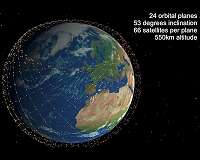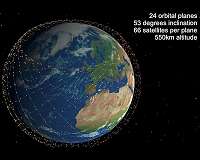Microsoft on Tuesday said its Azure cloud computing service is taking to outer space, and will deliver datacenter power to remote spots on Earth in the process.
The US technology titan announced partnerships with satellite operators including SpaceX, founded by Elon Musk, as part an “ecosystem” to serve networking needs in orbit as well as beam high-speed internet connections to modular datacenters that can be deployed almost anywhere.
“Azure Space” taps into Microsoft’s artificial intelligence and other cloud computing capabilities to meet the world’s growing networking needs, according to corporate vice president Tom Keane.
“We are ready to support customers on their space missions off and on the planet,” Keane said.
“And to use the power of cloud and space technology to help business across industries re-imagine solutions to some of the world’s most challenging problems.”
Azure Space is designed to handle vast amounts of data generated by satellites, and deliver cloud services and internet bandwidth to distant spots on Earth, according to Keane.
New partnerships with SpaceX Starlink and others will enable Microsoft to provide high-speed internet via satellite to new Azure Modular Datacenters, essentially self-contained cloud computing units about the size of shipping containers.
They were designed to easily put muscular computing power in “challenging environments,” according to Azure global industry sovereign solutions general manager Bill Karagounis.
“Scenarios range from mobile command centers, humanitarian assistance, military mission needs, mineral exploration, and other use cases requiring high intensity, secure computing on Azure,” Karagounis said in a blog post.
“The unit can operate in a wide range of climates and harsh conditions in a ruggedized, radio frequency shielded unit.”
Microsoft brought in space industry veterans to work with its product engineers to build computing capabilities tailored for the needs of space, including simulating missions and analyzing data gathered by satellites, according to Keane.
“Our approach helps to address the some of the toughest technology challenges that our customers face in space,” Keane said in a blog post.
“Coupled with our ecosystem of partners than can help bring this data to ground faster, we’re making it easier to find insights and make connections that weren’t possible before.”
Related Links
Space Technology News – Applications and Research
|
Thanks for being there; We need your help. The SpaceDaily news network continues to grow but revenues have never been harder to maintain.With the rise of Ad Blockers, and Facebook – our traditional revenue sources via quality network advertising continues to decline. And unlike so many other news sites, we don’t have a paywall – with those annoying usernames and passwords.Our news coverage takes time and effort to publish 365 days a year.If you find our news sites informative and useful then please consider becoming a regular supporter or for now make a one off contribution. |
||
|
SpaceDaily Monthly Supporter $5+ Billed Monthly |
||
paypal only
SpaceDaily Contributor
$5 Billed Once
credit card or paypal
Multi-state data storage leaving binary behind
Wollongong, Australia (SPX) Oct 13, 2020
Electronic data is being produced at a breath-taking rate.
The total amount of data stored in data centres around the globe is of the order of ten zettabytes (a zettabyte is a trillion gigabytes), and we estimate that amount doubles every couple of years.
With 8% of global electricity already being consumed in information and communication technology (ICT), low-energy data-storage is a key priority.
To date there is no clear winner in the race for next-generation memory that is non-vol … read more
– Advertisement –


